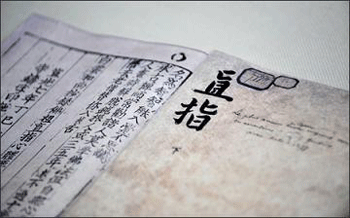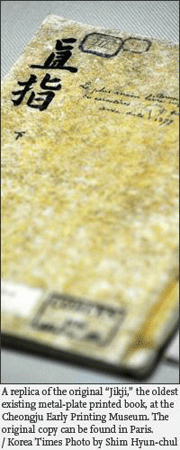 Seoul, South Korea — Korea is a country rich with world heritage properties. In particular, Korea invented the movable metal type in the 13th century and prides itself on being a country that values intellectual property. “Jikji,” whose full title is “Baegun Hwasang Chorok Buljo Jikji Simche Yojeol” (Master Baegun’s Excerpts from the Buddhas’ and Patriarchs’ Direct Pointing to the Essence of Mind), is one such property.
Seoul, South Korea — Korea is a country rich with world heritage properties. In particular, Korea invented the movable metal type in the 13th century and prides itself on being a country that values intellectual property. “Jikji,” whose full title is “Baegun Hwasang Chorok Buljo Jikji Simche Yojeol” (Master Baegun’s Excerpts from the Buddhas’ and Patriarchs’ Direct Pointing to the Essence of Mind), is one such property.
The oldest extant metal type printer in the world and registered on UNESCO’s Memory of the World list in 2001, “Jikji” is a Seon (Zen) text compiled by the Korean monk Baegun in 1372. The final page of “Jikji” says, “Printed and distributed at Heungdeok Temple outside Cheongju County in the seventh month of 1377.”
“Jikji” was printed in two versions: the metal type edition printed at Heungdeok Monastery in 1377 and the xylographic version printed at Chwiam Temple in 1378. It is the metal type edition that is registered on the Memory of the World list. This metallic version was originally composed of two volumes, but now only the second volume exists, missing the first leaf. Nevertheless, it is still possible to infer its full content because the two volumes of the xylographic version still survive to this day. “Jikji” is still being used in monastic education in contemporary Korea. An English edition was published in 2005.
However, the metallic edition of “Jikji” does not reside in Korea, but in the National Library of France (La Bibliotheque Nationale de France) in Paris. Collin de Plancy, who served in Korea as a diplomat, is  thought to have brought “Jikji” back with him to France at the beginning of the 1900s. Its existence there first became known to the public in 1901, when Maurice Courant, a specialist in East Asian Studies, published “Supplement to Korean Bibliography” (Supplement a la Biblioqraphie Coreenne). Henri Vever, a jewel seller and old book collector, purchased “Jikji” and donated it to the National Library of France in 1911. In 1972, Dr. Park Byeong-seon, who worked in the East Asian Section of the National Library of France, identified “Jikji” for the first time as the oldest metal type printing in the world.
thought to have brought “Jikji” back with him to France at the beginning of the 1900s. Its existence there first became known to the public in 1901, when Maurice Courant, a specialist in East Asian Studies, published “Supplement to Korean Bibliography” (Supplement a la Biblioqraphie Coreenne). Henri Vever, a jewel seller and old book collector, purchased “Jikji” and donated it to the National Library of France in 1911. In 1972, Dr. Park Byeong-seon, who worked in the East Asian Section of the National Library of France, identified “Jikji” for the first time as the oldest metal type printing in the world.
In recognition of “Jikji,” the Cheongju Early Printing Museum was established in Korea in 1992. UNESCO also launched the Jikji Prize, which is for individuals and groups who have contributed to the eradication of illiteracy, in 2005.
“Jikji” is composed of dharma teachings, hymns, eulogies, epitaphs, prose and poetry by the seven Buddhas, 28 Indian patriarchs, 110 Chinese Chan (Zen) monks and one Silla-era Korean monk. Its key concepts include non-duality, no-false mind and non-attachment to words.
The essential teaching of “Jikji” is sudden enlightenment followed by gradual cultivation: First, one should attain sudden enlightenment regarding the nature of existence, including the self; and after that, one needs to practice to get rid of dualistic way of thinking. Finally, if one’s thoughts come to be consistent with one’s actions, one can attain complete awakening and thus becoming a Buddha.
Unlike Western metal type printings that played a significant role in the publication of books for practical use as well as scientific texts, thus serving as the basis of the flowering of scientific civilization, “Jikji” has been used primarily as a text for monks.
However, “Jikji” holds its own distinctive characteristics, in particular, on theoretical matters. First of all, its purpose is to teach the notion of no false thought, which is the idea that we can attain enlightenment and free ourselves from the dualistic way of thinking. In essence, the Buddha and sentient beings are not separate; enlightenment and delusion are not separate; birth and death are not separate, etc.
“Ganhwa seon,” which emphasizes the observation of “hwadu,” or the topic of meditation, has been a dominant Buddhist doctrine in Korea since the fourteenth century. “Jikji” regards hwadu not as the only way to the Buddhist goal but merely as a skillful means to attain it.
In addition, the text emphasizes that what is important is not material possessions but a “pure mind.” Regarding this, it describes a conversation between Emperor Wu (464-549) of Liang China and Master Bodhidarma, the first patriarch of Chinese Chan Buddhism. The emperor was proud of his Buddhist activities, including the construction of monasteries. The Bodhidharma’s response was this: “You have not a scrap of merit.” The Master’s response has a thread of connection with the spirit of the late Master Beobjeong, who emphasized no attachment to anything (“mu soyu”).
“Jikji” also takes an open-minded stance toward Buddhist precepts. The Seon text rejected the perfunctory observation of such rules and even permitted wine and meat ? both taboos in Korean Buddhism ? for sacrificial rites.
It says, “One day Reverend Fenyang Wude said to the assembly, ‘Last night I dreamt of my late parents and I looked for alcohol, meat and paper money to offer in sacrifice, which I could not avoid, following lay customs. I placed these in order as a sacrifice to them.’” This means that “Jikji” interprets Buddhist precepts according to circumstances.
A 1997 issue of Newsweek claimed that Gutenberg’s invention of metal type printing in 1455 was the greatest human achievement of the past 1,000 years. Published 78 years before Gutenberg’s invention, “Jikji” stands as the oldest significant relic of the history of printing culture in the world and remains a source of pride for Koreans as an important part of their intellectual culture.
By Kim Jong-myung, The Korea Times




